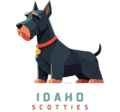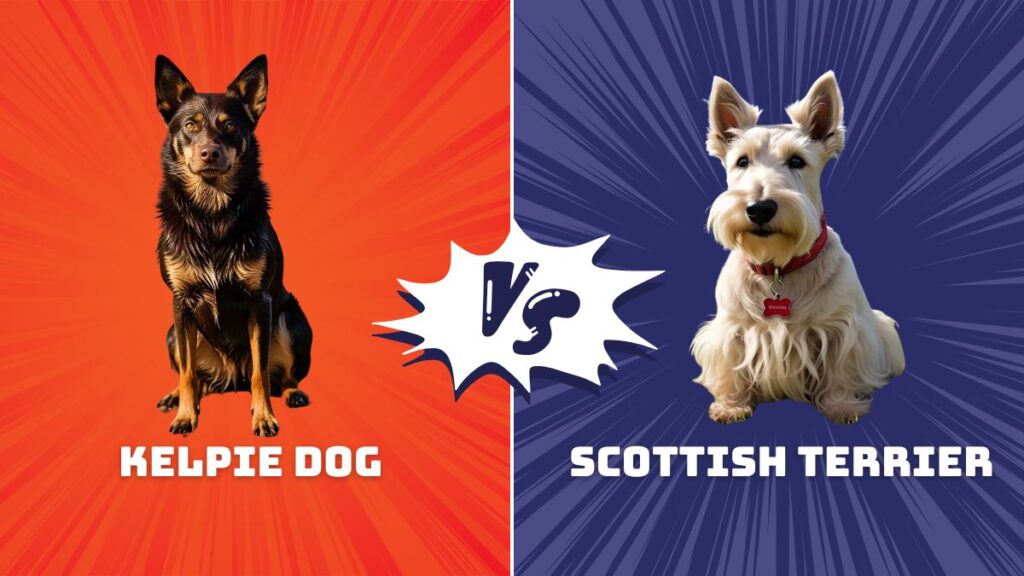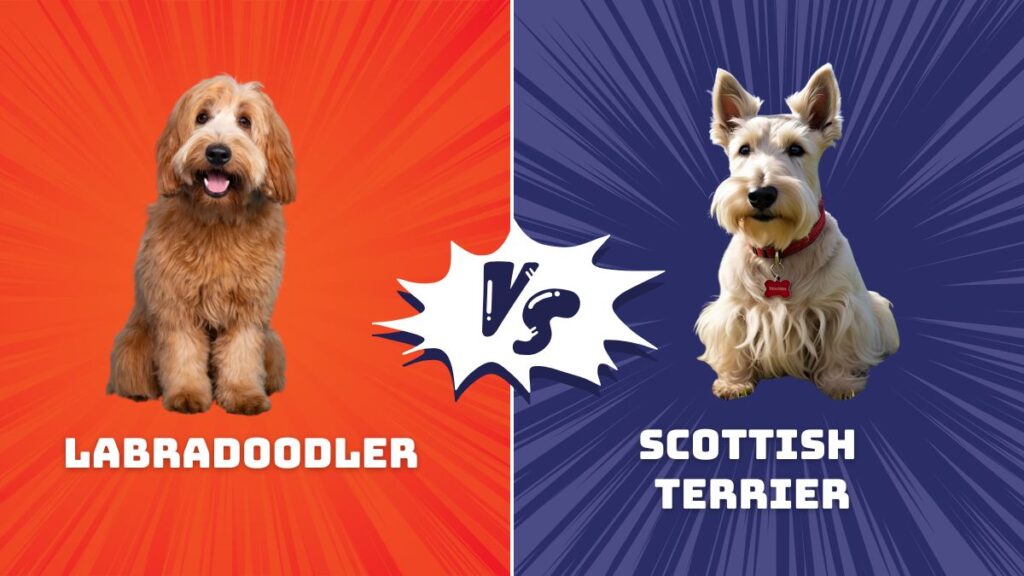Choosing the right dog is all about finding the right match for your lifestyle. Let’s look at the American Bully dog vs Scottish Terrier, two breeds that couldn’t be more different but are both wonderful companions.
The American Bully is big, strong, and super loyal. Despite their tough look, they’re gentle and loving, especially with kids. They’re great for families who want a big-hearted dog that’s protective and affectionate.
The Scottish Terrier, or Scottie, is small but full of personality. They’re independent, brave, and sometimes a bit stubborn, but they’re also loving and loyal. Scotties are perfect for smaller homes or apartments because they don’t need as much space or exercise.
When deciding between an American Bully dog vs Scottish Terrier, think about what fits your lifestyle. The Bully is great for families who want a bigger, protective dog, while the Scottie is perfect for those who prefer a smaller, independent companion.
Both are amazing pets, it just depends on the kind of dog you’re looking for!
American Bully Dog vs Scottish Terrier
Not sure which breed is right for you? Let’s break down the American Bully dog vs Scottish Terrier—exploring their key differences and helping you decide which one fits your lifestyle best!
Overview of Each Breed

Curious about which dog breed suits you best? Let’s take a closer look at each one—exploring their unique traits, personalities, and what makes them the perfect companion for different lifestyles!
American Bully
History & Origin
- Developed in the 1990s in the U.S.
- A mix of American Pit Bull Terrier, Bulldog, and Staffordshire Terrier
Purpose
- Originally bred for strength and loyalty
- Now known as a friendly, family companion
Physical Look
- Muscular build with a broad chest and a sturdy frame
- Short, smooth coat available in various colors
Personality
- Calm, friendly, and affectionate
- Great with kids and other pets
Scottish Terrier
History & Background
- Originated in Scotland, bred to hunt small animals (like rats and foxes)
- Has a long history as a symbol of Scottish heritage
Purpose
- Originally a working dog, now a loyal companion
Physical Look
- Compact and sturdy with a wiry coat
- Distinctive look with pointy ears and a proud stance
Personality
- Bold, independent, and sometimes stubborn
- Loyal to family but may be reserved with strangers
Physical Characteristics

Wondering what each breed looks like? Let’s dive into the physical traits of these dogs—how their size, coat, and appearance set them apart and make them so special!
American Bully
Size & Build
- Medium to large: Typically 16–20 inches tall and 70–120 lbs
- Muscular and strong, giving a powerful impression
Coat & Appearance
- Short, smooth, and low-maintenance coat
- Many coat colors (blue, fawn, brindle, etc.)
Lifespan
- Generally around 10 to 12 years
Scottish Terrier
Size & Build
- Small and compact: Around 10–11 inches tall and 18–22 lbs
- Despite small size, built tough and sturdy
Coat & Appearance
- Wiry coat that needs regular grooming
- Typical colors include black, brindle, or wheaten
Lifespan
- Typically 11 to 13 years, sometimes longer with proper care
Comparative Pointers
Space Needs
- Bully: Requires more room due to larger size.
- Scottie: Better for small spaces, like apartments.
Maintenance
- Bully: Lower grooming needs.
- Scottie: Requires more frequent brushing and occasional professional grooming.
Temperament and Personality

Curious about how these dogs act? Let’s explore their temperament and personality—how they behave, interact, and what makes them unique in character and companionship!
American Bully
Key Traits
- Calm, confident, and friendly
- Deeply loyal and eager to please
Family Life
- Excellent with children and other pets
- Loves being part of family activities
Social Nature
- Enjoys meeting new people and other dogs
- Generally sociable in various settings
Scottish Terrier
Key Traits
- Independent, confident, and sometimes stubborn
- Bold and self-assured
Family Life
- Loyal to its family but may be cautious around strangers
- More reserved than the Bully; prefers a quiet, stable home
Social Nature
- Can be territorial; early socialization is essential
- Benefits from firm, consistent training
Comparative Pointers
Social Interaction
- Bully: Very outgoing and enjoys company.
- Scottie: More reserved; may need time to warm up.
Training
- Bully: Generally easier to train with positive reinforcement.
- Scottie: Requires patience and consistency due to an independent streak.
Exercise, Training, and Activity Needs
Wondering how much exercise and training your dog will need? Let’s look at the exercise, training, and activity needs of each breed to help you keep them happy, healthy, and well-behaved!

American Bully
- Daily Exercise:
- Needs about 30–60 minutes of exercise daily (walking, playing, running)
- Enjoys both outdoor activities and interactive games
- Training Tips:
- Responds well to positive reinforcement (treats, praise)
- Early training and socialization are key to a well-behaved dog
- Mental Stimulation:
- Puzzle toys and interactive games can help keep the mind active
Scottish Terrier
- Daily Exercise:
- Moderate exercise is sufficient (30–45 minutes daily)
- Enjoys short walks and indoor play
- Training Tips:
- Training may require extra patience due to occasional stubbornness
- Firm, gentle training methods work best; consistency is essential
- Mental Stimulation:
- Loves interactive toys and short training sessions to keep engaged
Comparative Pointers
- Activity Level:
- Bully: More energetic and active; benefits from robust exercise.
- Scottie: Moderate activity is enough; ideal for quieter environments.
- Training Approach:
- Bully: Responds well to friendly, reward-based training.
- Scottie: Needs clear, consistent rules and patient repetition.
Grooming, Maintenance, and Health Considerations
Thinking about grooming and care? Let’s dive into the grooming, maintenance, and health needs of each breed, so you’ll know exactly what to expect in keeping your dog looking and feeling great!

American Bully
- Grooming Needs:
- Minimal grooming; a weekly brush and occasional bath will do
- Health Considerations:
- Prone to conditions like hip dysplasia and skin allergies
- Regular vet checkups and a balanced diet are important
- Care Tips:
- Monitor weight to prevent obesity
- Provide a balanced diet and regular exercise to maintain muscle tone
Scottish Terrier
- Grooming Needs:
- Requires more attention: Regular brushing and professional grooming every 6–8 weeks
- Health Considerations:
- May encounter issues like Scottie Cramp or joint problems
- Routine vet visits help catch issues early
- Care Tips:
- Keep nails trimmed and ears clean
- Regular grooming sessions are key to keeping their wiry coat neat
Comparative Pointers:
- Maintenance:
- Bully: Lower maintenance with simple brushing.
- Scottie: Higher maintenance due to regular grooming requirements.
- Health Checkups:
- Both breeds benefit from regular veterinary care to catch and manage potential issues.
Living Environment and Lifestyle Fit
Wondering if your home is the right fit for a new dog? Let’s explore the living environment and lifestyle needs of each breed, helping you find the perfect match for your space and daily routine!

American Bully
- Best Living Spaces:
- Suited for homes with yards or larger outdoor spaces
- Suburban or rural areas are ideal
- Family Lifestyle:
- Great for active families who enjoy outdoor activities
- Needs room to move and play; more space helps avoid boredom
- Pointers:
- Make sure you have time for daily exercise
- Consider a home with a secure yard for safe play
Scottish Terrier
- Best Living Spaces:
- Well-adapted to apartment living and smaller homes
- Does well in urban settings as long as daily walks are provided
- Family Lifestyle:
- Ideal for quieter households, seniors, or singles
- Prefers a calm environment with routine daily activities
- Pointers:
- A small home or apartment is fine, but ensure there’s space for short daily walks
- Routine is important for this breed, so a stable environment works best
Comparative Pointers
- Space Requirements:
- Bully: Needs more space and a backyard.
- Scottie: Fits well in smaller spaces like apartments.
- Lifestyle Compatibility:
- Bully: Better for families who are active and outdoors often.
- Scottie: Best for those seeking a loyal companion in a more relaxed setting.
Pros and Cons of Each Breed
Not sure which breed is right for you? Let’s take a look at the pros and cons of each dog, so you can weigh the benefits and challenges before making your decision!
American Bully
Pros
- Loyal, loving, and great with children
- Easy to train with positive reinforcement
- Lower grooming needs due to short coat
Cons
- Requires plenty of space and regular exercise
- Can be prone to certain health issues (e.g., hip dysplasia)
- May require more socialization if not exposed early to other dogs and people
Scottish Terrier
Pros
- Compact size makes them great for smaller homes
- Bold, independent, and full of character
- Loyal and protective of their family
Cons
- Can be stubborn, requiring extra patience during training
- Higher grooming needs due to the wiry coat
- May be reserved or cautious around strangers, needing early socialization
Comparative Pointers
For Families
- Bully: Great if you have children and a spacious home.
- Scottie: Better for a smaller, quieter household or if you prefer a smaller dog.
For Training
- Bully: Typically easier to train with rewards.
- Scottie: May need a firm and consistent approach.
Additional Pointers to Consider
Thinking about adding a new dog to your family? Let’s go over some extra tips to keep in mind—helping you make the best choice and ensure your dog thrives in its new home!
Time Commitment
- Both breeds require time for exercise, training, and grooming.
- Make sure your daily schedule allows you to spend quality time with your new pet.
Budget
- Consider the costs of food, vet care, and grooming.
- American Bullies might need a bit more food due to their size, while Scottish Terriers might incur higher grooming costs.
Lifestyle and Activity Level
- If you’re an active person who loves the outdoors, the American Bully’s energy may be a great match.
- If you prefer a calmer lifestyle, the Scottish Terrier’s moderate activity needs may suit you better.
Experience with Dogs
- First-time dog owners might find the American Bully’s eagerness to please a plus.
- If you have experience and patience, a Scottish Terrier’s independent nature can be well-managed.
Family Dynamics
- Consider how the dog will interact with all family members.
- A dog that thrives on human interaction, like the Bully, might be better in a bustling household.
- The Scottie, though loyal, might prefer a bit more quiet time.
Outdoor vs. Indoor Living
- Evaluate your living situation: Do you have a secure outdoor area?
- If not, the Scottish Terrier may be easier to manage in an apartment, provided you commit to daily walks.
Socialization
- Early socialization is important for both breeds.
- Introduce your dog to various people, other dogs, and environments to ensure a well-rounded personality.
Personal Preferences
- Think about the size and appearance that appeals to you.
- Consider whether you want a dog that makes a big, bold statement or one that’s more compact and discreet.
Long-Term Commitment
- Dogs can live 10 to 13 years, so be ready for a long-term commitment.
- Both breeds require consistent care and attention over the years.
Making the Final Decision
When it comes down to choosing between the American Bully and the Scottish Terrier, ask yourself:
- Do I have enough space and time for a larger, active dog?
- Am I looking for a companion that is easy to train and very social?
- Would I prefer a smaller dog that fits well in an apartment and has a bit of an independent streak?
- How important are grooming and maintenance to my daily routine?
By considering these questions, you can better decide which breed is right for your lifestyle.
Tips for a Smooth Transition
Ready to bring your new dog home? Let’s explore some helpful tips for a smooth transition—making sure your new companion settles in comfortably and feels right at home from day one!
Meet the Breed
- Visit local shelters or breeders to meet dogs in person.
- Spend time with both breeds to see which one connects with you.
Talk to Experts
- Ask veterinarians, trainers, or current owners about their experiences.
- Their insights can help clarify what living with either breed might be like.
Trial Run
- If possible, consider fostering a dog before committing.
- This gives you a hands-on way to see how the dog fits with your daily routine.
Plan for Training
- Set aside time each day for short training sessions.
- Use treats and praise to build a positive learning environment.
Prepare Your Home
- Dog-proof your living space, ensuring you have a safe area for your new friend.
- Purchase necessary supplies like a dog bed, toys, and grooming tools.
Recap and Final Thoughts
Choosing between an American Bully and a Scottish Terrier depends on several factors. Here’s a quick recap:
American Bully
- Best for active families with ample space.
- Larger, muscular, and easy to train.
- Lower grooming needs but may have certain health issues.
Scottish Terrier
- Ideal for smaller homes or apartments.
- Compact, bold, and independent.
- Requires more grooming and a bit more training patience.
Ultimately, both breeds can be amazing companions. Your lifestyle, living space, and how much time you have for exercise and training are all important considerations. Take the time to meet the dogs, ask questions, and really imagine how each breed would fit into your life.
Remember, the right dog is the one that will love you back every day, no matter its size or personality.
Pet trainer with a passion for helping animals and owners build strong, loving bonds through positive reinforcement and expert care.



